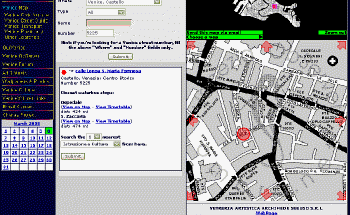 During my last trip to Venice, I was reminded of two things – first, addresses in Venice are nearly useless; and second, the Venetian dialect is not Italian. Thankfully, I found two websites which help with these issues.
During my last trip to Venice, I was reminded of two things – first, addresses in Venice are nearly useless; and second, the Venetian dialect is not Italian. Thankfully, I found two websites which help with these issues.
Addresses in Venice may make perfect sense to the Venetians, but when you’re not from around those parts it can feel like they’re a cruel joke played on tourists so that the locals can watch us stumble around the city. I always wonder if the residents are peering down from their windows, just waiting for some hapless tourist with his nose in a map to walk straight into a canal. I mean, when you’re given the address of Castello 5225, which is essentially just the name of the district (Castello) and the street number (5225) but without the all-important name of the street that number is on, you’d be forgiven if you were to throw your hands up in the air and just give up. It boggles the mind how anyone can look at such an address and pinpoint it on a map without more than a second’s thought. But a new friend of mine in Venice let me in on a little secret – there’s a website that locates addresses in Venice based on nothing more than something as seemingly unhelpful as Castello 5225. It’s the VeniceXplorer site.
With VeniceXplorer, you can just type in whatever address it is that you’re looking for and a map will appear with a red pulsating dot over the right spot in the city. It’s something akin to a miracle, as far as I’m concerned, but I’ve long been suspicious that computers are smarter than me. This is just more proof.
To use the mapping feature of the website, click on “Venice Civic Number” from the left-hand menu on the main page. On the next page that comes up, select the district from the first drop-down menu, and type in the number in the box next to the word “Number.” Then click the “Submit” button. That’s it. You may actually be blessed with a street name in the address you have, but you don’t even need it on this website. In fact, the times I tried typing the street name into the box next to the word “Name” it didn’t get me any results – but leaving the name off got me exactly what I wanted. I suppose this is another case of “less is more.”
After you’ve hit “Submit,” a link below the “Submit” button will appear with the address you’re looking for – usually including a street name – and when you click on that you’ll get to a new page with a map, pulsating red dot on the spot you’re looking for, and information to the left of the map about the nearest vaporetto stops. Genius.
The second website I think could prove useful, although it’s the kind of thing that you can’t really use in the exact moment that you need it, is a glossary of Venetian words. Some of these are just Italian words which you could see anywhere in the country, but many are unique to Venice (or the Veneto in general). The first page of the glossary has food-related words (I love how they start with food – in Italy it’s all about eating in the end, isn’t it?), but there are four other pages of other terminology you may see in Venice. It’s through browsing through this Venetian glossary website that I discovered I ate something called “canoce,” or sea cicada, during my trip. I also learned that the word “calle,” which seems to be what every other little street is called, means “narrow street.”
At any rate, as I mentioned earlier, I’m not sure the Venetian glossary is as useful in the moments you’re really going to need it – unless you’ve got a web browser on your mobile phone in the restaurant when you’re trying to decipher the menu, of course – but it could be enlightening after the fact, as it was for me.